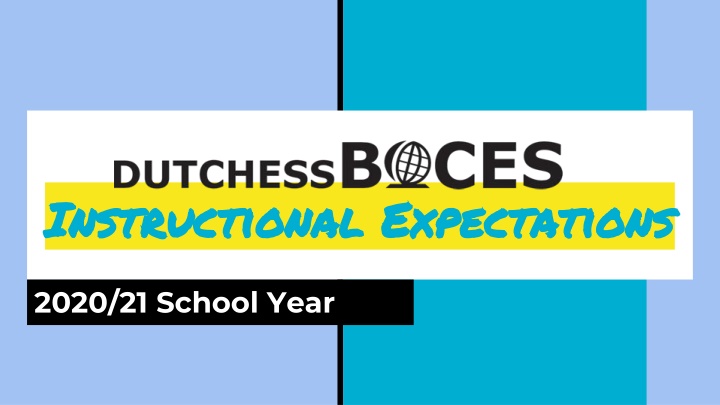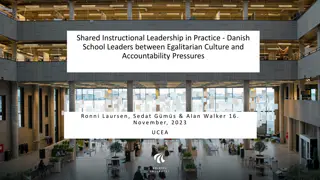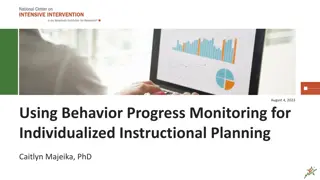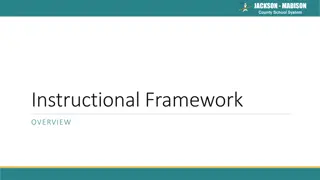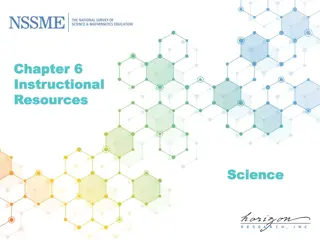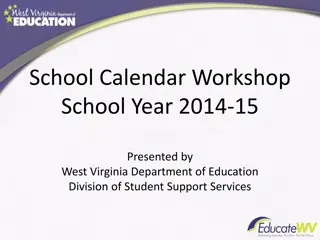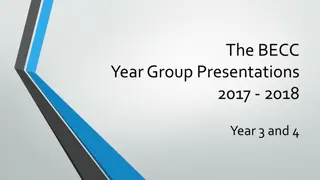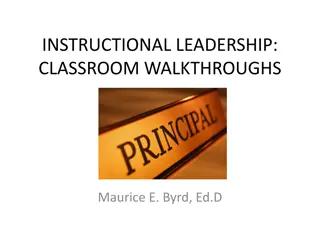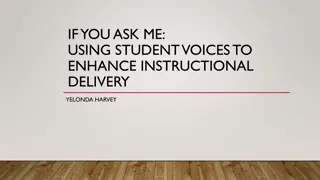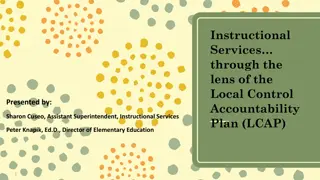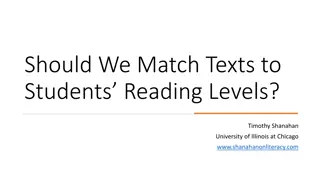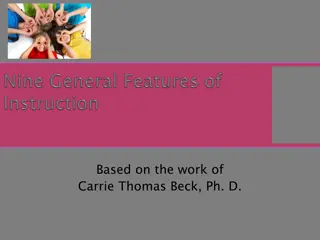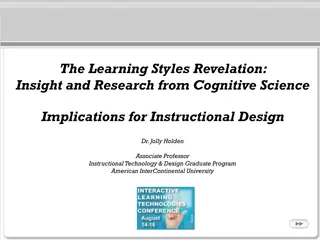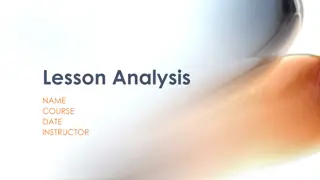Instructional Expectations for the 2020-21 School Year
Our primary commitment at Dutchess BOCES is to the safety of our students and families. The upcoming school year will bring new challenges due to COVID-19, requiring clear guidance and innovative approaches to academic learning, social-emotional well-being, and long-term outcomes for students. Explore pedagogical strategies, daily expectations, and student support initiatives to prepare for a different on-campus schooling experience. Embrace flexible pedagogy to adapt to changing circumstances and ensure an effective learning environment for all.
Download Presentation

Please find below an Image/Link to download the presentation.
The content on the website is provided AS IS for your information and personal use only. It may not be sold, licensed, or shared on other websites without obtaining consent from the author.If you encounter any issues during the download, it is possible that the publisher has removed the file from their server.
You are allowed to download the files provided on this website for personal or commercial use, subject to the condition that they are used lawfully. All files are the property of their respective owners.
The content on the website is provided AS IS for your information and personal use only. It may not be sold, licensed, or shared on other websites without obtaining consent from the author.
E N D
Presentation Transcript
Instructional Expectations Instructional Expectations 2020/21 School Year
OUR WHY? OUR WHY? At Dutchess BOCES our primary commitment is to the students and families we serve. Our priority must be keeping them safe. When the 2020-2021 school year begins, on-campus school will look much different than previous years due to COVID-19 and the health and safety measures that continue to evolve. The Instructional Expectations will define clear guidance for the reopening of our classrooms and programs that aligns with the regulations developed in collaboration with NYSDOH and the NYS Education Department
HOW WHY Academic Learning, Social Emotional well being and Long Term Life Outcomes for Students.
What we will cover I. Pedagogy (In-Person/Virtual Instructional Models, Daily Expectations, Staff Roles & Responsibilities) II. Explicit Instruction (Lesson Planning, NYSED Instructional Mandates & Virtual Students) III.Student Support (MTSS, Community Building, Accessibility, Management Needs, Related Services, Google Classroom/Voice, Technology & Professional Development) IV.Planning for the First Two Weeks with Students (Resources for Health and Safety, Social/Emotional Learning Strategies & Setting Up Physical/Virtual Space)
Pedagogy (In-Person/Virtual Instructional Models, Daily Expectations, Staff Roles & Responsibilities) Section I
In Person Instructional Focus Power Standards Prioritizing Face-to-Face time Student Centered Thinking Hands-On Activities Community Building and Social Thinking Strategies
Daily Expectations Flexible Pedagogy: With flexible resilient pedagogy, you ll create ONE set of activities that can work both face-to-face and online. It won t matter if you re teaching in your classroom or remotely next week, or if some of your kids are home and some with you in school, because you have a plan that works for any scenario. What I envision is creating structures and frameworks that can be reused over and over again, not only throughout this school year, but for many years to come because they are flexible and resilient to circumstantial change. EP202-Resilient-Pedagogy https://drive.google.com/file/d/1kktS4G1RHFHlPgqcanXUxpRGswUk4DTz/view?usp=sharing
Here are just a few examples of activities you probably know how to do in-person but can also be done virtually via free tools: Exit tickets Math manipulatives Reading journals Jigsaw Choice boards/learning menus The TQE method Centers/station rotations Retellings, reflections, and responses Digital notebooks Small group discussion Reading books and real world texts Kahoot group learning + review games Think-pair-share (cyber sandwich) for discussing text/understandings (modified for K-2) Links to Tools in this Document: Links to Tools in this Document: https://drive.google.com/file/d/1kktS4G 1RHFHlPgqcanXUxpRGswUk4DTz/view ?usp=sharing With flexible resilient pedagogy, you ll create ONE set of activities that can work both face-to-face and online. It won t matter if you re teaching in your classroom or remotely next week, or if some of your kids are home and some with you in school, because you have a plan that works for any scenario.
Staff Roles & Staff Roles & Responsibilities Responsibilities Virtual TAs Virtual TAs https://docs.google.com/document/d/1_D636RTCpwITS https://docs.google.com/document/d/1_D636RTCpwITS EEohj3epWGaxY2tB0jJjzDH9J155Hs/edit?usp=sharing EEohj3epWGaxY2tB0jJjzDH9J155Hs/edit?usp=sharing
Hybrid Teaching Model What is Hybrid Learning? Although hybrid schools have been around for more than a decade, the concept is still relatively new and unknown to most. Essentially, a hybrid school combines traditional in-person, brick-and-mortar education with online learning. The hybrid component refers to a physical environment that blends in-person and remote (at-home) learning. Every hybrid school approaches this combination differently. The amount of time students are spending in the building vs learning at home/online will vary from school to school, as will the nature and pacing of online resources. The Hybrid Teacher Survival Guide https://drive.google.com/file/d/1qWiiZl5lfPG97N1UgYbzaOjn31j4iseB/view?usp=sharing
Tips for Hybrid Teaching 1. Staying organized in how you post your work and communicate with your students is key to their academic success. 2. Cohesive and consistent systems among classes/colleagues help students navigate the online environment. 3. Students and parents have communication preferences. Ask them specifically how they d like to communicate with you (text, email, Google Classroom) and they ll be more likely to respond. 4. The amount of time available to complete a task is the amount of time it will take. If you give yourself all day to plan a lesson, it will take all day. If you give yourself an hour, it will take (just a little more than) an hour. Use timers to help you manage your time, and teach students to do the same. 5. Students are adaptable and resilient don t underestimate them. 6. YOU are adaptable and resilient don t underestimate yourself.
Synchronous Instruction Virtually Sample Schedule
suggestions for creating a successful virtual learning environment
Setting Norms and Expectations in a Virtual Learning Environment Setting Norms and Expectations in a Virtual Learning Environment Teachers are accustomed to dedicating the start of every school year to establishing the norms and expectations of their class. Part of that process is introducing students to the physical classroom space and helping students understand how to navigate it. A virtual classroom is no different. Start the year with a tour of the virtual environment, teach your students how to use the different functions of the video conferencing platform, and be sure to clearly establish your norms and expectations.
1. You must be present and actively engaged in the lesson Being present and actively engaged means the students need to be in front of the screens for the entire lesson without physically wandering off to the bathroom or kitchen, or digitally wandering off to other games or tabs. They also need to be actively engaged in the lesson. It is all too easy for a student to join the session, turn off their camera, and wander off to do other things. Online, synchronous lessons require students to be actively responding to questions and participating in the instructional time.
2. Microphones must be muted unless told otherwise While many video conferencing softwares have functionality that will allow you to mute or remove participants, clear expectations, strong relationships, and engaging lessons are the best possible behavior management strategies.
3. The chat box must be on-topic once the lesson starts There are numerous ways in which the chat box can be used, students often prefer to use it as a social tool, always give students an opportunity to be social at the start of class, this helps build community. At the start the lesson, verbally remind them of the norms and expectations, and tell them that from this moment on the chat box needs to be on topic.
DCBOCES Hybrid Instructional Schedule DCBOCES Hybrid Instructional Schedule Monday Tuesday Wednesday Thursday Friday COHORT A COHORT A Some Specific Students On Site for Related Services On Site On Site Remote Remote Remote Remote On Site On Site COHORT B COHORT B All others Remote
Explicit Instruction Explicit Instruction Sample Lesson Plan Template https://docs.google.com/document/d/1k28AhKPRfVqEjWGAZdWMkoXUUgtp4nmrefAcWvT4nnM/edit?usp=sharing
Explicit Instruction (Lesson Planning, NYSED Instructional Mandates & Schedules) Section II
Explicit Instruction https://drive.google.com/file/d/1_gR2jFsMNO5pt6LbVezGuwLHkLk2lnz6/view?usp=sharing Dutchess BOCES Starts School Year Thursday [PIC] Dutchess BOCES Employee Schedule Convocation Banner 2020 Dutchess BOCES Board of Trustees President Edward L. McCormick and District Superintendent Dr. Richard Hooley will welcome employees back beginning at 8:45 a.m. on Thursday, September 3.
Lesson Planning DCBOCES expectation is that all planning should be recorded electronically. Although we are not requiring a single resource, here is an example of one that can be tailored and personalized to your needs, it can be downloaded right into your Google Slides: https://slidesmania.com/free-edu-digital-planner-made-with- google-slides-with-hyperlinks/
Schedules & Instructional Requirements (NYSED)
Teaching and Learning Teaching and Learning Mandatory Requirements: Mandatory Requirements: All schools must plan for in person, remote and hybrid models of instruction Instructional decisions must be equitable and standards based and accessible to all students. There needs to be routine, scheduled time for students to seek feedback from their teachers. Instruction must be provided by an appropriately certified teacher with substantive interactions regardless of delivery. Include how students needing additional social, emotional, and academic support will be supported Allow ample time for students to re-adjust to the school setting. Provide staff with opportunities to meet to discuss student needs. Offer training and support for students and caregivers to ensure comfort and ease with technology.
Grades K Grades K- -6 6 There are no subject specific time requirements for K-6. Schools should employ the best available instructional practices and resources to maximize instructional time and support. PE is important and students should be participating in physical activities under the supervision of a certified physical education teacher.
Grades 7 Grades 7- -12/Units of Study 12/Units of Study Grades 7-12 Mandatory Requirements: Schools should consider the time requirement of 180 minutes of instruction as a benchmark. Schools must decide if the instruction provided for the 2020-21 school year is comparable in rigor, scope, and magnitude to a traditionally delivered 180 min/week unit of study. CTE social distancing practices for clinical hours Work-based learning Collaborate with businesses to identify work based opportunities (priority given to students who need work based hours for graduation requirements) Definition of Unit of Study At least 180 minutes of instruction per week. Equivalent means at least 180 minutes of instructional time delivered face to face or through alternative experiences. Must represent standards-based learning under supervision of an appropriately certified teacher. Must include (but not limited to) meaningful and frequent interaction with a teacher, academic, and other supports, and instruction content that reflects an expectation as in-person instruction.
Suggestions for Students Virtual Only Literacy addressed everyday, whether explicit or embedded through direct or independent practice Grades K Grades K- -5 5 Synchronous: Morning Meetings and Check-Ins (3 times per week) Asynchronous: Instruction should have, at most, two videos and a action item to provide feedback at their ability level Instructional Focus Monday/Tuesday: ELA & SS Focus Wednesday: Community Building SEL Thursday/Friday: Math & Science
Suggestions for Students Virtual Only Grades 6 Grades 6- -12/CTE Subject Areas 12/CTE Subject Areas Synchronous: Check-Ins (3 times per week) Asynchronous: Instruction should have, at most, three/four videos and a action item to provide feedback at their ability level in each subject area Instructional Focus in Each Subject Area Monday: Video & Activity Tuesday: Discussion Opportunities Wednesday: Community Building SEL Thursday: Choice & Exploration Friday: Submission
K-12 During the Day (Teachers & Teaching Assistants) Checking email and Google Classroom Stream Create/provide Instructional Videos specific to topic, subject area (Carefully Cultivated Resources) Provide Independent Practice (Ex. I-Ready, Project Based Learning, Rubrics) Organize Content to make sense with clear direction Lead live meetings and post your contact information and hours
Student Support (MTSS, Community Building, Accessibility, Management Needs, Related Services, Google Classroom/Voice, Technology & Professional Development) Section III
RTI Model RTI Model
Building a Community Virtually Learning Styles Inventory
Accessibility Making Google Classroom Accessible
Student Management Needs Student Management Needs Student Management Needs/Accommodations/Modifications section on IEP must be reviewed and implemented accordingly during interim virtual instruction. Teachers should keep in mind the challenges students and families face as they try to navigate online learning. Ex. ensuring appropriate breaks, time to stretch, etc. should be provided on a regular basis throughout the morning. Remember the challenges some of our students have when in person? Those same difficulties may be exacerbated when trying to learn online.
Quick Movement Ideas (Google Search for More) Would you rather... Dance up a storm Freeze Dance 5-4-3-2-1 In this simple game, students stand up and the teacher (or leader) has them do five different movements in descending order Break out in song Simon Says Stretching/Yoga Pretend you are a (Lion, Horse, etc)... Students should have breaks should be scheduled during all transitions, they can be quick
Teacher/Staff Teacher/Staff Responsibilities Responsibilities for for Online Online Learning Learning 1. Use of Google Classroom; 2. Post student expectations for online learning; 3. All Building Administrators, academic integration teachers), and students IEPs) must be added as co-teachers to your classroom; 4. Post lessons and activities weekly; 5. Teachers are required to provide students with live/synchronous learning for specific days and times. 6. Social/Emotional impact of online learning. Online Teaching Expectations for Teacher/Staff https://docs.google.com/document/d/1k6V1JS1f1dysUzWbEtEvhDBDWM0FZt G1sNno4Vw-6_I/edit?usp=sharing co-teachers RSP (as appropriate based on (consultant teachers,
Related Service Providers RSP must use calendar & meet to schedule sessions with students through G suite (Use the menu icon, click either as the creator or student for access to the calendar OR meet icons) This way it will not be confused with classroom academic groups, and other services scheduled. Karyn Lange must be included on all of the RSP meets scheduled with students. If any administrator or colleague joins your Meet after you've begun instruction please continue teaching, to prevent interrupting the dynamic. If you have multiple teachers or RSP in a meet at once, please review among yourselves prior to instruction how you will be operating to maximize student engagement and involvement throughout the instructional block.
Google Classroom (Logistics) https://docs.google.com/document/d/1NzJxj6B-win3FU_qLCysbHAStojwbfuXKUEQ1rtgXNY/edit?usp=sharing
Students Online Responsibilities 1. Students MUST be enrolled in their Google Classroom regardless of the method of activity completion (paper-based or digital). Students should be using their BOCES Ids to log-in. 2. It is expected that students will complete assignments during this online-learning experience to the best of their ability. 3. Students will be held accountable for work during this time. 4. Students should log in each day to view assignments, and complete them in a timely fashion. 5. Students (and/or parents) should contact the teacher via email or on the classroom stream with general questions or concerns regarding assignments. Any questions that are student specific should be asked through email, text message or phone call. 6. Teachers will remain available via email throughout the school day. 7. Students must demonstrate participation in order to be assessed on IEP Goals.
Resources WE'RE HERE TO HELP! WE'RE HERE TO HELP! We want to make the transition to online learning easier for educators and parents. Check out the BOCES link below for educator resources, tips and advice for online learning. https://www.dcboces.org/node/1729 COVID RESOURCES https://docs.google.com/document/d/17B1oWfbdvghr7VmgPA6xhX2-UsVLW17ebBAcqdbv7fQ/edit?usp=sharing
Technology Most students already have tech needs met as per the survey information we have. If additional needs come up, we will address. Please communicate any needs to your immediate supervisor.
Google Voice In order to maintain communication effectively with families teachers/RSP will be checking in with parent/guardian X times per week. To do so effectively staff can/will? Use a Google Voice number This will allow staff to maintain their personal phone number privacy, as well as forward appropriate communications to administration Please follow the link to register with Google Voice Good Voice Setup
Professional Development/Training Google Classroom: Including effective online lesson design-synchronous/asynchronous Explicit Direct Instruction Providing Feedback Screencastify - recording lessons PBIS Online- Setting Expectations, Online Behaviors to Acknowledge, Digital Acknowledgements, CICO Support Social-emotional supports online
Planning for the First Two Weeks with Students Planning for the First Two Weeks with Students (Resources for Health and Safety, Social/Emotional Learning Strategies & Setting Up Physical/Virtual Space) Section IV
